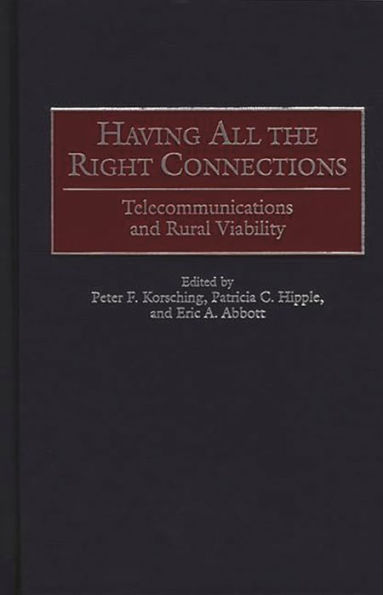Having All the Right Connections: Telecommunications and Rural Viability
Essays, based on five years of survey research in Iowa and case study examples from across the United States, examine the implications of telecommunications technologies for rural community development. Supported by data from five years of survey and case study research, telecommunications adoption and use is explored in nine sectors of the rural community to determine the influence these organizations and institutions have on telecommunications development within the broader rural community. These sectors include local government, economic development, business, newspapers, library services, health care, university extension to communities, and farming. Also considered are the factors that promote and retard telecommunications development, particularly the impact of telecommunications policy, the availability of state-of-the-art infrastructure and service, and the involvement of telephone companies in local community development. Using a community development framework, this work discusses the physical, financial, human and social capitals necessary for holistic community development and the significance of critical mass, the roles of internal and external networks, as well as vertical and horizontal linkages, and the importance of visionary leadership and the championing of telecommunications.
Social Science and telecommunications scholars will appreciate the interdisciplinary approach these case studies represent. In addition, this research is intended to assist local leaders, community service providers, businesses, community officials, and state policy makers in capturing the potential benefits of innovative telecommunications technologies for local economic development, while avoiding potential problems and pitfalls. Essays are organized in three sections. The first presents theory, policy, and issues within a community development framework. The second discusses perspectives and actions of community sectors in their adoption and use of telecommunications. The third examines what occurs within an organization as it implements a new telecommunications system. Charts and graphs enhance the text and a glossary of terms is provided.
"1132779911"
Social Science and telecommunications scholars will appreciate the interdisciplinary approach these case studies represent. In addition, this research is intended to assist local leaders, community service providers, businesses, community officials, and state policy makers in capturing the potential benefits of innovative telecommunications technologies for local economic development, while avoiding potential problems and pitfalls. Essays are organized in three sections. The first presents theory, policy, and issues within a community development framework. The second discusses perspectives and actions of community sectors in their adoption and use of telecommunications. The third examines what occurs within an organization as it implements a new telecommunications system. Charts and graphs enhance the text and a glossary of terms is provided.
Having All the Right Connections: Telecommunications and Rural Viability
Essays, based on five years of survey research in Iowa and case study examples from across the United States, examine the implications of telecommunications technologies for rural community development. Supported by data from five years of survey and case study research, telecommunications adoption and use is explored in nine sectors of the rural community to determine the influence these organizations and institutions have on telecommunications development within the broader rural community. These sectors include local government, economic development, business, newspapers, library services, health care, university extension to communities, and farming. Also considered are the factors that promote and retard telecommunications development, particularly the impact of telecommunications policy, the availability of state-of-the-art infrastructure and service, and the involvement of telephone companies in local community development. Using a community development framework, this work discusses the physical, financial, human and social capitals necessary for holistic community development and the significance of critical mass, the roles of internal and external networks, as well as vertical and horizontal linkages, and the importance of visionary leadership and the championing of telecommunications.
Social Science and telecommunications scholars will appreciate the interdisciplinary approach these case studies represent. In addition, this research is intended to assist local leaders, community service providers, businesses, community officials, and state policy makers in capturing the potential benefits of innovative telecommunications technologies for local economic development, while avoiding potential problems and pitfalls. Essays are organized in three sections. The first presents theory, policy, and issues within a community development framework. The second discusses perspectives and actions of community sectors in their adoption and use of telecommunications. The third examines what occurs within an organization as it implements a new telecommunications system. Charts and graphs enhance the text and a glossary of terms is provided.
Social Science and telecommunications scholars will appreciate the interdisciplinary approach these case studies represent. In addition, this research is intended to assist local leaders, community service providers, businesses, community officials, and state policy makers in capturing the potential benefits of innovative telecommunications technologies for local economic development, while avoiding potential problems and pitfalls. Essays are organized in three sections. The first presents theory, policy, and issues within a community development framework. The second discusses perspectives and actions of community sectors in their adoption and use of telecommunications. The third examines what occurs within an organization as it implements a new telecommunications system. Charts and graphs enhance the text and a glossary of terms is provided.
95.0
In Stock
5
1

Having All the Right Connections: Telecommunications and Rural Viability
368
Having All the Right Connections: Telecommunications and Rural Viability
368Hardcover
$95.00
95.0
In Stock

Product Details
| ISBN-13: | 9780275965822 |
|---|---|
| Publisher: | Bloomsbury Academic |
| Publication date: | 07/30/2000 |
| Pages: | 368 |
| Product dimensions: | 6.00(w) x 9.00(h) x 0.94(d) |
| Lexile: | 1490L (what's this?) |
About the Author
From the B&N Reads Blog
